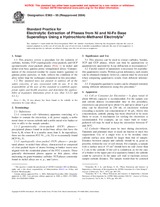We need your consent to use the individual data so that you can see information about your interests, among other things. Click "OK" to give your consent.
ASTM E963-95(2004)
Standard Practice for Electrolytic Extraction of Phases from Ni and Ni-Fe Base Superalloys Using a Hydrochloric-Methanol Electrolyte
STANDARD published on 1.11.2004
The information about the standard:
Designation standards: ASTM E963-95(2004)
Note: WITHDRAWN
Publication date standards: 1.11.2004
SKU: NS-48619
The number of pages: 4
Approximate weight : 12 g (0.03 lbs)
Country: American technical standard
Category: Technical standards ASTM
Annotation of standard text ASTM E963-95(2004) :
Keywords:
borides, carbides, electrolytic extraction, Gamma prime, GCP phases, superalloys, TCP phases, ICS Number Code 77.120.40 (Nickel, chromium and their alloys)
Additional information
| Significance and Use |
|
This practice can be used to extract carbides, borides, TCP and GCP phases, which can then be qualitatively or quantitatively analyzed by X-ray diffraction or microanalysis.2 Careful control of parameters is necessary for reproducible quantitative results. Within a given laboratory, such results can be obtained routinely; however, caution must be exercised when comparing quantitative results from different laboratories.3 Comparable qualitative results can be obtained routinely among different laboratories using this procedure.3 |
| 1. Scope |
|
1.1 This practice covers a procedure for the isolation of carbides, borides, TCP (topologically close-packed), and GCP (geometrically close-packed) phases (Note 0) in nickel and nickel-iron base gamma prime strengthened alloys. Contamination of the extracted residue by coarse matrix (gamma) or gamma prime particles, or both, reflects the condition of the alloy rather than the techniques mentioned in this procedure. This standard does not purport to address all of the safety concerns, if any, associated with its use. It is the responsibility of the user of this standard to establish appropriate safety and health practices and determine the applicability of regulatory limitations prior to use. (See 3.3.2.1 and 4.1.1.) Note 1 Ni3 Ti (eta phase) has been found to be soluble in the electrolyte for some alloys. |
We recommend:
Technical standards updating
Do you want to make sure you use only the valid technical standards?
We can offer you a solution which will provide you a monthly overview concerning the updating of standards which you use.
Would you like to know more? Look at this page.




 Cookies
Cookies
